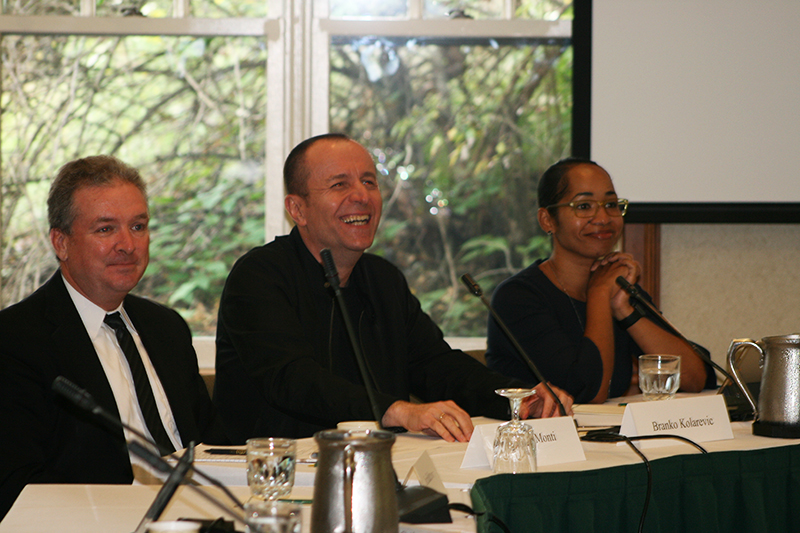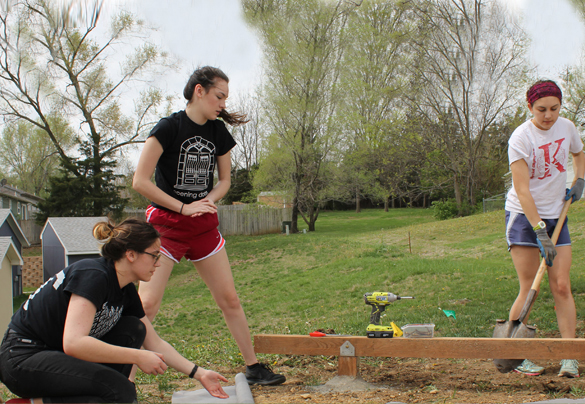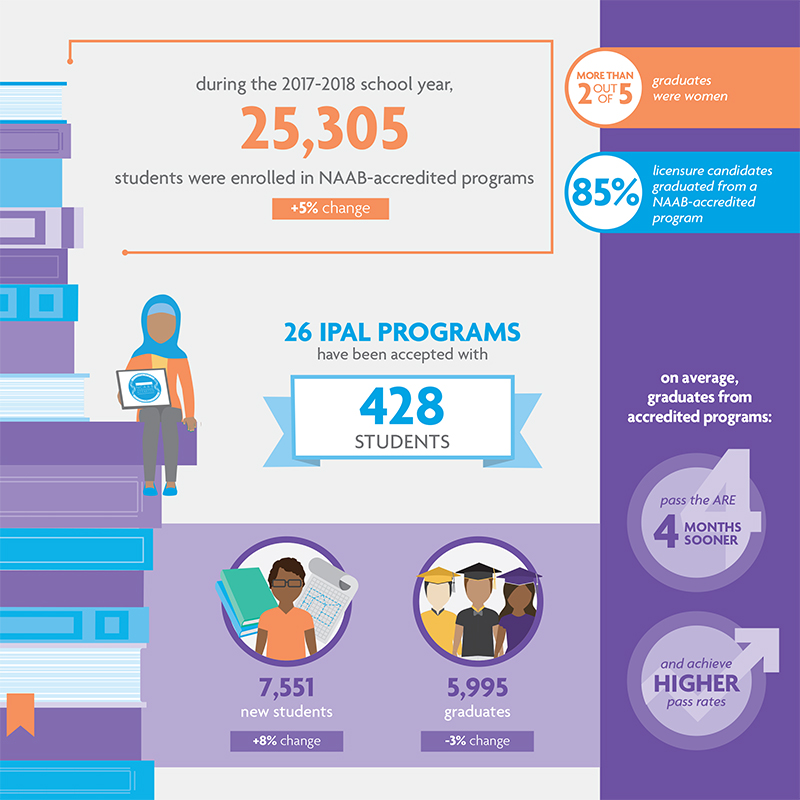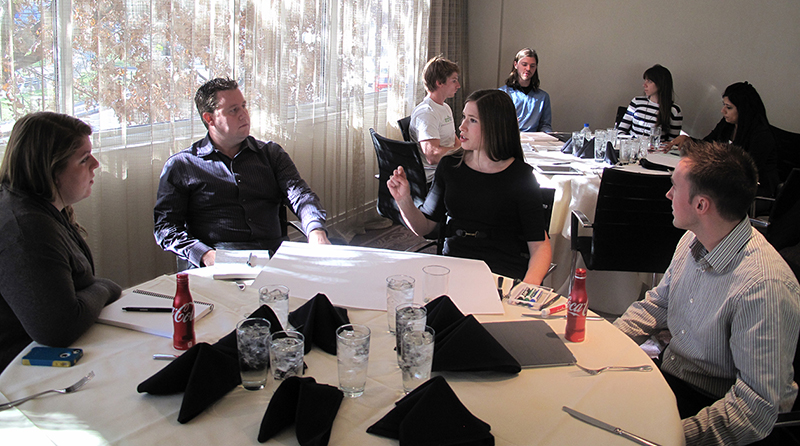Collateral Engagement
As new emphasis on collaboration and communication took hold at NCARB, the organization sought out opportunities with a wider audience. By partnering with related organizations, NCARB works to advance joint issues and keep the architecture profession moving forward.
Fostering Collaboration
Throughout the past two decades, one theme has underpinned each of the organization’s successes: collaboration. New partnerships emerged from growing relationships both within and outside of the architecture profession. As NCARB evolved, the organization also worked to create more opportunities to engage with individuals who often didn’t have a voice in the architecture profession.
Collateral Partners
Starting in 2003, NCARB’s executive leadership met with their counterparts at the American Institute of Architects (AIA) for a biannual summit to discuss initiatives, concerns, and opportunities for collaboration and alignment. Building on this, NCARB’s Board set a precedent of inviting leadership delegation from either the Association of Collegiate Schools of Architecture (ACSA), the American Institute of Architecture Students (AIAS), or the National Architectural Accrediting Board (NAAB) to one of their Board meetings each year. The conversations raised awareness of the issues facing each organization, identified mutual interests, and built trust. Establishing these official channels of communication demonstrated the value of collaboration, making it integral to NCARB culture.

In 2016, NCARB provided support to the AIAS Freedom by Design program—a volunteer-based initiative that empowers college students to improve their community through modest design solutions. Since then, NCARB has donated over $100,000 in grants for building materials and facilitated mentorship opportunities with licensing board members.

With guidance from local architects and construction mentors, student projects have ranged from wheelchair ramps and community gardens to sensory playgrounds for children with disabilities. The unique program also helps prepare the next generation of architects for the realities of practice, and students can use their experience to help satisfy the Architectural Experience Program’s® (AXP®) requirements.

“Freedom by Design is one of the best available opportunities for students to acquire real-world experience in design, construction, project management, budgeting, client and consultant relations, teamwork, and leadership.”
Another area of partnership is professional practice curricula. In 2018, NCARB began working with the ACSA to explore how professors, firm leaders, and young professionals perceive current professional practice education, and whether it is truly preparing licensure candidates for real-world practice.
Each year, NCARB partners with the NAAB on several issues, providing volunteers for accreditation visits as well as representatives on the NAAB Board of Directors. Additionally, the NAAB provides data on architectural education for each issue of NCARB by the Numbers, and staff have held office hours at NCARB's booth during the AIA Conference on Architecture to answer education-related questions for attendees.

And by working with the AIA, NCARB is able to tackle a number of issues, including diversity in the profession and deregulatory efforts that could threaten public health, safety, and welfare. NCARB also hosts regular outreach events at AIA chapters around the United States.
Finding New Voices
Throughout the Council’s evolution, the voice of one group intimately connected to NCARB’s programs had been missing from its deliberations: licensure candidates. For many years, the people using the exam and the experience program were not able to serve on NCARB’s committees, in order to avoid conflict of interest or exposure to policy decisions. However, as key users, their valuable perspective was absent. In 2011, a "Think Tank" of candidates who could provide insight on the effectiveness of the Council’s programs was proposed by staff and eagerly accepted by leadership.

Out of the first meeting emerged a new dialogue and the start of a stream of useful ideas for tweaking aspects of NCARB’s programs. Just as important, the energy, enthusiasm, and fresh eyes of Think Tank participants demonstrated the positive impact that young professionals could have on NCARB’s programs and services if given the chance. Over the next seven years, the Think Tank would become a consistent forum for program assessment, generating ideas for future initiatives. Their recommendations led to the experience reporting app, resources for supervisor training, renaming the Intern Development Program (IDP), and more.
In 2018, the success of the Think Tank led to the creation of a new group: the Re-Think Tank, composed of recently licensed architects. Together with the Think Tank, they help assure that real-time feedback shapes current and emerging programs.

External Partners
As NCARB faced the start of its second century, it occupied a new place at the forefront of professional regulation. Increased interaction with other members of the Federation of Associations of Regulatory Boards (FARB), the Inter-organizational Council on Regulation (ICOR), and partners in professions including landscape architecture, engineering, accountancy, nursing, and others provided opportunities to share best practices across regulatory bodies and advocate for reasonable regulation, streamlined programs, and the value of licensure.
“Our focus is being proactive, rather than reactive. By distinguishing architecture as a profession rather than an occupation, rebuffing myths regarding mobility opportunities, and demonstrating our ability to evolve with the changing nature of architectural practice, we can prevent uninformed attacks on public safety.”
In the deregulatory environment of the late-2010s, NCARB’s work and its desire for collaborative strategies are proving useful and relevant to a much broader audience. Early results suggest the efforts are worthwhile. Legislators proposing deregulation in several states have taken a new approach after discussing architecture’s hard-won reciprocity model with NCARB staff. And in 2018, the Federal Trade Commission (FTC) released a report praising the NCARB Certificate as a model pathway to mobility that other professions would benefit from adopting—an important validation for NCARB.
Photo credit:
- Students from the University of Kansas participating in the Freedom by Design Program, April 2017. Photograph. Courtesy of AIAS.